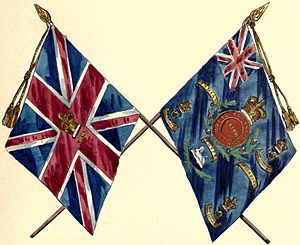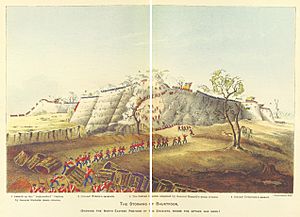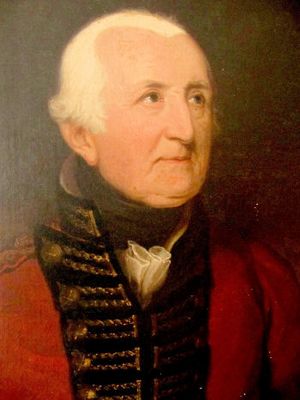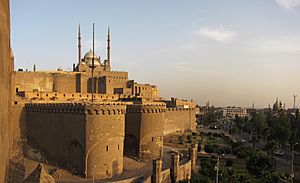86th (Royal County Down) Regiment of Foot facts for kids
Quick facts for kids 86th (Royal County Down) Regiment of Foot |
|
|---|---|

Regimental colours
|
|
| Active | 1793–1881 |
| Country | |
| Branch | |
| Type | Infantry |
| Size | One battalion (two battalions 1813–1814) |
| Garrison/HQ | Victoria Barracks, Belfast |
| Engagements | French Revolutionary Wars Second Anglo-Maratha War Napoleonic Wars Indian Rebellion |
The 86th (Royal County Down) Regiment of Foot was a group of soldiers, like a team, in the British Army. They were formed in 1793. This group was an infantry regiment, meaning they were soldiers who fought on foot. Later, in 1881, they joined with another group, the 83rd (County of Dublin) Regiment of Foot, to become the Royal Irish Rifles. This change was part of bigger army updates called the Childers Reforms.
Contents
History of the 86th Regiment
How the Regiment Started
The 86th Regiment began in Shropshire, England. Major-General Sir Cornelius Cuyler started it on October 30, 1793. It was first called Sir Cornelius Cuyler's Shropshire Volunteers. This was because of worries about the French Revolution happening at the time.
The next year, in 1794, the group officially joined the British Army. It was then known as the 86th (Shropshire Volunteers). In January 1795, the soldiers started serving as marines and went on ships. They took part in a sea battle called the Battle of Hyères Islands in July 1795.
Later that year, in October 1795, they welcomed soldiers from another group. This group, the 118th Regiment, had been disbanded.
Early Adventures Abroad
The regiment traveled to the Cape of Good Hope (in modern-day South Africa) in September 1796. Their job was to make sure the British were in charge there. The Dutch forces had given up control earlier that month.
In February 1799, the soldiers went to Madras in India. They arrived in May 1799 and then moved to Bombay in July 1799. From there, some companies (smaller groups of soldiers) went to Ceylon in late 1800.
Fighting in Egypt and India
In April 1801, the regiment sailed to Egypt for the Egyptian Campaign. They landed at Suez and marched a long way across northern Egypt. The French Army gave up Cairo in June 1801. After that, the 86th Regiment took over the citadel in Cairo.
The regiment returned to Bombay in spring 1802. They then helped in two attacks during the Siege of Bharatpur in January 1805. This was during the Second Anglo-Maratha War. Sadly, these attacks were not successful, and 25 soldiers from the regiment died.

The regiment went back to Bombay in March 1806 and then to Goa. In October 1809, their name changed to the 86th (Leinster) Regiment of Foot.
Napoleonic Wars and Beyond
The regiment took part in the Invasion of Île Bonaparte in July 1810. After the Invasion of Isle de France, they stayed on the island (now Mauritius) in March 1811. They returned to Madras in February 1812.
In May 1812, their name changed again to the 86th (Royal County Down) Regiment of Foot. In January 1816, they moved to Hyderabad. From there, they helped stop a group called the Pindaris. They sailed to Trincomalee in Ceylon in September 1818. There, they helped stop the Kanyians. Finally, they sailed home in April 1819.
The Victorian Era and Final Years
In October 1826, the regiment sailed to the West Indies. They were first in Trinidad, then Barbados in 1828, Antigua in 1830, and Demerara and Berbice in 1833. They returned home in March 1837.
They went back to India in 1842. They fought in Central India during the Indian Rebellion. They were part of a force led by Major-General Sir Hugh Rose. This force surrounded and captured Jhansi Fort in April 1858. Four soldiers from the regiment earned the Victoria Cross for their bravery in this battle.
The regiment returned home in August 1859. They then went to Gibraltar in 1864, Mauritius in 1867, and the Cape of Good Hope in 1870. They came home again in 1875 and then went to Bermuda in 1880.
In the 1870s, the army made changes called the Cardwell Reforms. These changes linked regiments together. The 86th Regiment was linked with the 83rd (County of Dublin) Regiment of Foot. They shared a training base in Victoria Barracks, Belfast. On July 1, 1881, more changes happened, called the Childers Reforms. The 86th Regiment officially joined with the 83rd Regiment to become the Royal Irish Rifles.
Brave Actions and Awards
The regiment earned special honors for their courage in battles. These are called Battle Honours:
- Egypt (with a sphinx symbol)
- India, Bourbon, Central India
Victoria Cross Heroes
Four soldiers from the 86th Regiment received the Victoria Cross. This is the highest award for bravery in the British military. They earned it during the Indian Rebellion of 1857 at Jhansi in 1858:
- Captain Henry Edward Jerome
- Lieutenant Hugh Stewart Cochrane
- Private James Byrne
- Private James Pearson
Images for kids











